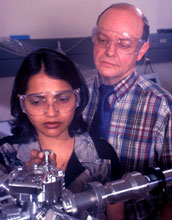Multimedia Gallery
New integrated circuit cleaning technique
A new integrated circuit cleaning technique developed by Dennis Hess, a chemical engineering professor at the Georgia Institute of Technology. The new technique streamlines the integrated circuits (ICs) (miniature assemblies of electronic components vital to the electronics industry) fabrication process and makes it more environmentally friendly. Pictured here is graduate student Tazrien Kamal, who is showing Hess a treated sample in his lab.
In order to function properly ICs must be ultraclean, therefore, production of ICs is done in an ultraclean environment called a "clean room." There are about 400 processing steps involved in making a typical IC. Fifty to 60 of these steps involve cleaning the various surfaces involved in the process. Most of the cleaning is done using liquids--usually acids and bases--and time must be allowed for drying. However, Hess' new technique eliminates the drying step, streamlining the process and making it more environmentally friendly than the methods currently used because it uses water instead of toxic and corrosive chemicals.
Hess heats water to temperatures above the boiling point, while simultaneously adding pressure to keep the water in the liquid phase. After cleaning is complete, Hess reduces the pressure and flashes the liquid off the surface. The next step for Hess will be collaboration with IC equipment and device manufacturers to try out his method on actual IC wafers. [This research was funded in part by a grant from the Natoinal Science Foundation.] (Year of image: 2000)
Credit: Photo by Sue Clites
Images and other media in the National Science Foundation Multimedia Gallery are available for use in print and electronic material by NSF employees, members of the media, university staff, teachers and the general public. All media in the gallery are intended for personal, educational and nonprofit/non-commercial use only.
Images credited to the National Science Foundation, a federal agency, are in the public domain. The images were created by employees of the United States Government as part of their official duties or prepared by contractors as "works for hire" for NSF. You may freely use NSF-credited images and, at your discretion, credit NSF with a "Courtesy: National Science Foundation" notation.
Additional information about general usage can be found in Conditions.
Also Available:
Download the high-resolution JPG version of the image. (533 KB)
Use your mouse to right-click (Mac users may need to Ctrl-click) the link above and choose the option that will save the file or target to your computer.

